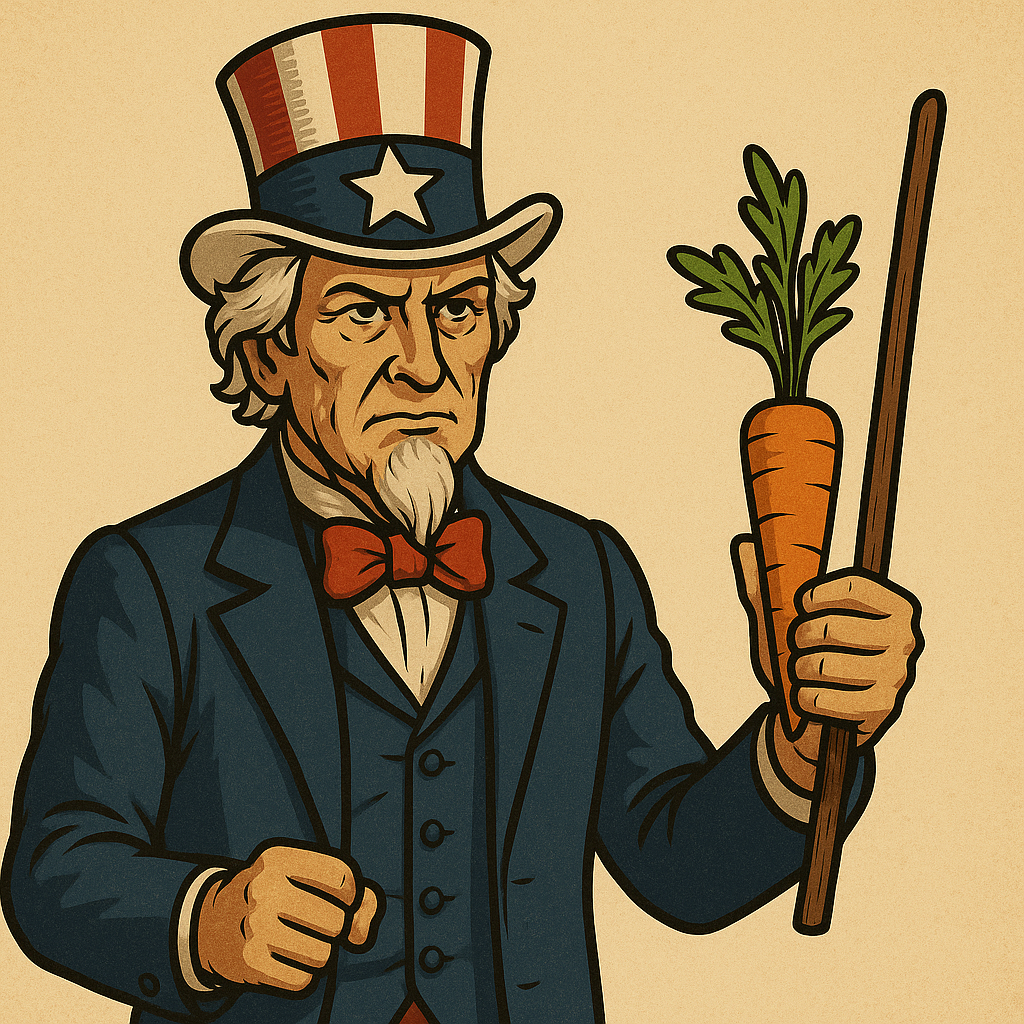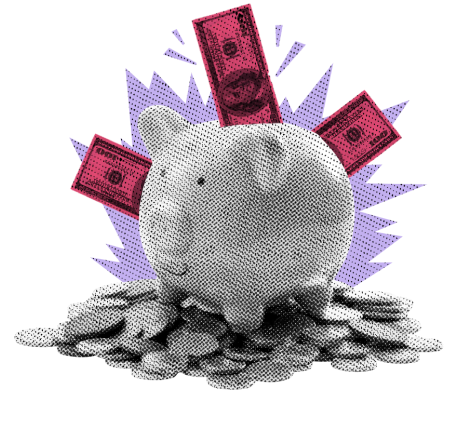
What if we stopped punishing companies and started incentivizing them instead?
KEY TAKEAWAYS
- Tariffs were originally used to generate government revenue before the creation of the income tax system.
- Today’s U.S. tariffs are mostly about protectionism, not revenue.
- In practice, tariffs act as an extra tax on U.S. companies and consumers.
- There are more targeted and strategic alternatives, like subsidies and government procurement incentives.
- While those alternatives may reduce revenue, they can strengthen national competitiveness and job creation.
MY HOT TAKES
- Tariffs are essentially a second tax on consumers.
- Using tariffs for protectionism is inefficient and outdated.
- Strategic carrots—like subsidies and tax breaks—are more effective than blunt-force sticks.
- U.S. deficits don’t justify piling on economically harmful tariffs.
- Game theory reminds us: there's no perfect solution, so we should pick the least-worst one.
- You can quote me: “In essence a tariff becomes a tax to companies and consumers. But we are already being taxed by the IRS for income. It is an additional tax—a tax hike.”
Spare the rod. Ok, let’s get back to tariff basics. Why would any country want to charge tariffs? Well, in the olden days, countries used tariffs to raise money for government coffers. Back in the day, there was no income tax, so a country could only raise revenue by charging duty taxes. The US famously financed the payoff of debt from the Revolutionary War using tariffs. The brainchild of the now famous Broadway star Alexander Hamilton imposed heavy tariffs when he served as the country’s first Treasury Secretary. To be clear, he also came up with a whiskey excise tax which, along with the import tariffs, was pretty successful at paying down the debt. So, tariffs as a source of revenue makes some sense in the absence of other forms of revenue.
Now that we have the history books cracked open, it wasn’t until the Tariff of 1816, that the US first used tariffs as a protection mechanism. The tariffs were also used to finance the lingering costs of the War of 1812. There were several other tariff regimes in the US, namely The Tariff of Abominations, the Walker Tariff, the Morill Tariff, and the famous… er, infamous 1890 McKinley Tariff. Most were primarily for protection, but, of course, revenue never hurt. The US made a couple of failed forays into income tax in the 1800s, but ultimately the 16th Amendment made income tax a full time thing in 1913. The amendment granted Congress the right to tax.
These days, the US still spends more than it can afford, and that has been recently thrown into sharp focus as Congress seeks to ratify a reconciliation tax package and Moody’s cut the US debt rating. Still, the US takes in some $4.4 trillion a year in tax revenue from NON-TARIFF sources, mostly you and me in income tax (50%). Indeed, the US is not wanting for sources of income, it just spends more than it makes. 🤔 Anyway, the point here is that the US does not need to use tariffs as a source of revenue. And though the President has mentioned that the US will make “lots” of money through tariffs, it is clear that he is more interested in the protective nature of tariffs than as a source of revenue.
This is how that works in an overly simplified model. The government charges import taxes to US companies. US companies, because of the tax, suffer from margin compression. To avoid that, the companies raise consumer prices to cover the added tax cost. Consumers, who are theoretically price sensitive, will not buy those goods at higher prices. They, instead, will seek out cheaper alternatives, which should be domestically made products that are not burdened with the tariff. In other words, buy the Ford Bronco instead of the Range Rover. That last example wasn’t a joke, though I am sure you have already recognized that a Bronco is not quite a substitute for a Range Rover which could be as high as 27.5% depending on which tariff applies at the moment. Maybe this is not the perfect example. But wait, there is more.
Range Rover, which will either lose sales due to price hikes or lose income by eating the tariff cost, might decide to simply produce its trucks in the US to avoid the tariff. Hey, now that is a cool concept. It would create US manufacturing jobs! That is a political win and a win for the American worker. Side note: there is no lack of jobs available today for American workers as there were 313,000 vacancies in durable goods manufacturing as of March.
Ok, ok, jobs would be nice, but clearly not critical. How about protecting our security interests. There are certain products that are so important to the US, they should be produced domestically. Pharmaceuticals are the usual first suspect to be brought up in this context. Much of those are manufactured in Asia, India, and Germany. What if those countries sought to harm US interests and cut the US off? It could be a disaster. What if the supply chain gets messed up by a pandemic and those drugs are stuck overseas? That would never happen, would it? 🤣 What about critical components for US military products or critical components for transportation like airplane assemblies, or jet fuel refined from foreign crude oil. Going further yet, what about chips critical to keep the US lead in AI technology?
Now, it is clear that the US should protect its industrial and security interests. It is also clear that the government should ensure that all Americans have an opportunity to earn a decent living. Jobs, security, even some revenue make so much sense at a high level, doesn't it? There is just one problem with this scenario: who is going to pay the bills for all that? Well, my friends, if tariffs are used the answer is simple. Companies, consumers, or both. Not China, not India, Canada, or Mexico. In fact, not even the US government. US companies will get the first bill, and they will choose how much, if any, to charge you and me.
In essence a tariff becomes a tax to companies and consumers. But we are already being taxed by the IRS for income. It is an additional tax–a tax hike. Look, when it comes to taxes, less is always better, but I am not going to complain about paying more tax if it helps advance the country’s interests or security. But how much is the right amount? This all begs a question: are there other ways to achieve these goals?
The answer to that is also simple, yes! Why would a company import a widget component for its products? Because it is cheaper to manufacture overseas. The government can give subsidies and tax incentives to companies who manufacture domestically. This can be done simply and very accurately, targeting sub-industries and products.
The government can also invest in domestic infrastructure projects that create local jobs. The government is the single largest consumer in the US! Buy American! Instead of charging Apple 25% on all its China-produced iPhones, why not pledge to procure only iPhones for government use IF Apple manufactures them in the US. Sure, it will pay more to cover the increased cost, but it would serve to bring production onshore AND create jobs! Going back to the Bronco, why not allow US manufactured vehicle purchases to be a tax write-off? The US could simply exempt all US-based manufacturing from corporate tax. Did you know that corporate income tax only represents 10% of the government's tax revenue?
All these are examples of how the US can achieve its same protectionist goals, however these are carrots, while tariffs are sticks. Now, I recognize that all of these alternatives mean less revenue for the government which would serve to exacerbate the already growing deficit challenge. However, in this case, the increase in deficit is easily justified as an investment into the country’s future. This would serve to put more money in consumers’ pockets and strengthen American companies, making them more competitive. It would seem like a win-win scenario. Imperfect and fraught with its own challenges? Yes, of course, but given that all choices in this game come with costs, it would seem that the carrot might be the most viable option. We need only to look at the Prisoner’s Dilemma, a classic game theory simulation. There is no perfect solution, so the least-worst one yields the winner. Despite the cost, there can be a winner. Will the US and its companies come out the winner? Better yet, what about you and me?
YESTERDAY’S MARKETS
Stocks sold off yesterday as traders with nerves of glass panic-sold ahead of NVIDIA’s post-close earnings announcement. Not, the right choice, but hindsight is 20/20, especially on Wall Street. The Fed is worried about a recession according to minutes from its last FOMC meeting. Stocks shrugged off the news, especially given that tariffs are on hold… at least for now.

NEXT UP
- Annualized Quarterly GDP (Q1) is expected to come in at -0.3% in line with the prior estimate.
- Initial Jobless Claims (May 24) is expected to come in at 230k, slightly above last week’s 227k claims. Watch this relative to its 4-week moving average which was around 231k last week. Pro tip: above is bad, below is good. 😉
- Pending home sales (April) may have slipped by -1.0% after jumping by 6.1% in March.
- Fed speakers today: Barkin, Goolsbee, Kugler, Daly, and Logan.
- Important earnings today: Burlington Stores, Foot Locker, Bath & Body Works, Veradigm, Kohl’s, Best Buy, Gap, Costco, Marvell, Dell, NetApp, Zscaler, UiPath, American Eagle Outfitters, and Ulta Beauty.
.png)

